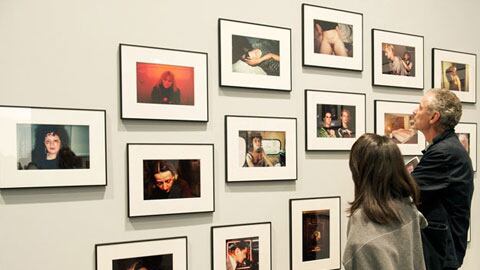Some of the effects of the economic crunch were apparent to the naked eye at Art Basel. “It’s washed out some of the froth, some of the frills, some of the deluxe,” said Michael Findlay of Acquavella Galleries. In fact, the art stars of the late boom—Damien Hirst, Takashi Murakami, Anselm Reyle, etc.—mostly had pieces here and there but they weren’t exactly up front and central. Until recently, the Hirst Spot paintings had frequently supplied the background in newspaper photographs of magnates on the go. Now, the only ones I saw were on a shopping bag in the café L’Escale.
View our Gallery of the Best of Art Basel

The dealers, mostly veterans at this, the grandest and sleekest of the Big Four fairs of modern and contemporary art—the others being the New York Armory, London’s Frieze and Basel’s frisky sibling in Miami—had made little attempt to conceal their apprehensions. These were quickly lulled. ‘It’s a big surprise after London. We’ve been selling to Swiss and Germans for about six weeks. We just sold a Barry Flanagan to a German,” said Leslie Waddington, the dean of London’s Cork Street. “As a matter of fact, they are more than all right,” said Antonio Homem of Manhattan’s Sonnabend Gallery. “Also it has to do with the fact that we came from New York where things are really depressed. In Europe, they are less so.”
Gordon VeneKlasen of the Michael Werner Gallery of Berlin and New York said: “It’s OK. There’s money out there.” He noted that people have less confidence in other places they can put their money. “Art is one of the only ways you can move it around. I hope that lasts,” he said.
Of course, it is not as it was. Contemporary art has shed the lunatic spurt growth of 2007 and 2008 and more. Across the board, it is still perhaps 30 percent below its peak. “Everybody’s talking about how well the back rooms are doing,” said the artist Leonard Bullock. “They are looking for something that’s off the main wall. It’ll be cheaper and it’s something that they can think they have discovered.”
I asked Projjal Dutta of Aicon, a London gallery specializing in Indian art, which was in the satellite fair, Scope, if things were coming back by and large?
“Is there a by and small?” Dutta asked. “Things are coming back by and small.”
The sales being made were really not possible. Adam Sheffer in the New York gallery Cheim & Read had just sold a Jack Pierson to a female collector, who had been puzzled as to where to install it, so she was flying him to the Riviera to do just that.
“She even said she’d buy me a bathing suit,” he said.
The piece was assembled from metal signage and read SIN.
I pointed out that there were two such pieces on their floor.
“ This one is going to Cannes. And that one is going to Korea, So I guess I’m lucky,” Sheffer said.
Don Rubell, the ebullient Florida collector, who was in town with his wife, Mera, put the rebound down to the sheer quality of the stuff at the main fair. “Everybody brought the best they had here,” he said. “I haven’t seen it this good in 15 years. It’s extraordinary. We had a very good one and a half hours here. Then people realized things are selling.”
Which was when the bargains dried up.
View our Gallery of the Art Basel Satellite Shows

So the art market is looking reasonably good. But what of the actual art? “We’re in a very strange moment,” says James Mayor, the Cork Street gallerist. “Either there’s a thousand artists you haven’t heard of or there’s Giacometti at the Beyeler.”
Art Basel is best known as a marketplace, but alongside is the space called Unlimited, which is where creative curators get to do their stuff, so this was where visitors should have got a sense of the emergent artscape but in this regard things seemed distinctly iffier. It’s not that the proceedings lacked energy. One morning, a crowd got to listen to Jeff Koons and ask questions too (One asked what advice Koons had for young artists).
On just one day, Hans Ulrich Obrist, capo of the Serpentine Gallery in London, conducted a joint interview with two Russian artists—“the mysterious specifics if the Russian soul” were mentioned—then presided over the launch of a book, The China Interviews, with a Philip Tinari, who was identified as director of the “Office for Discourse Engineering, Beijing.” The Brave New Art World can be fond of such Orwellian titles.
But alongside this humming hive, the work seemed a downer, a numbing acreage of dull-witted academic conceptualism and installations that drain energy out of a space rather than fill it. But just when your spirits start to flag and the bar at the Three Kings begins to float mirage-like in your mind, you would bump into something that kept you going.
Michael Werner had hung Sigmar Polke’s four golden cloud paintings in a room with the kind of lighting that movie directors use to indicate heaven. And alongside the Polkes, Sean Kelly was showing Leaving (with Two Minute Silence), an installation by Anthony McCall. McCall is by way of being a friend so naturally I had misgivings. But I entered an all-black corridor, took a right and walked into a cone of light. It looked as compellingly material as luminous shell and diminished to a point on what seemed to be a distant wall. A three-angled shape was projected alongside. Interrupting these solid beams with your body was thrilling. A terrific piece.
If the Unlimited is haunted by banality, a surge of product geared to feed the careerist appetites of the multiheaded curatorial beast, the besetting sin of the satellite fairs is the cutesy-poo. Many of these artists would doubtless either have been salonistas in an earlier generation or arts-and-crafty but they have picked up all sorts of sly postmodernist tricks.
There were, of course, some strong pieces. I had liked Alexander Pomomarev in Venice—he had a submarine in the Grand Canal, one of the fleet of notional submarines that supposedly stand in for international artists—and he had some drawings at the Barbarian-Art Gallery at Volta and Leo Villareal, one of the rare artists to bridge the fine art world with that of Burning Man (where—disclosure—I have stayed in his camp) was in the Conner Gallery, also at Volta, with an LED-fed light piece, the junior sibling of his extraordinary piece integrated into the I.M. Pei ceiling of the National Gallery of Art, Washington.

Design Basel delivered the real jolt, though. As tends to be the case at design fairs, much of the goods on view were dire, but a few were peerless and here I would single out the work shown by the Carpenter’s Workshop. Part of these were shown in Never Ever Land, an outside display on tasteful green Astroturf which included some seats and a table by Marc Quinn and such pieces from the Atelier van Lieshout as a Sensory Deprivation Skull chair and a Mini Capsule Hotel. “People are dropping in all the time, just to have a snooze,” said the curator Natalie Kovacs.
She added that Brad Pitt had just bought the mini-capsule.
What was Lieshout up to now?
“I’m now working on a nice piece on cannibalism,” Joep van Lieshout told me on the phone.
At the Carpenter’s Workshop stand within, was a piece by rAndom International, a London/Berlin collective, consisting of Hannes Koch, Flo Ortkrass, and Stuart Wood. Sixty-four smallish oblong mirrors are clustered together on an apron of space, standing on twin metal feet. When anybody enters that space, the mini-mirrors come alive, as alert as small dogs, tilting, turning and bending, in artful mimicry of thought processes, and at dissimilar speeds, as though each were an individual, although the power and the distinct reactions are generated by an overhead camera that is trained on the interloper in the space.
The piece, which is called Audience, has no design function whatsoever. Why is it in Design Basel?
“Because we are product designers,” Hannes Koch says, sensibly. He added that “The main thing that it does is turn people into perfomers. It’s a role reversal. That wasn’t really planned, But it happened anyway.”

Audience focuses on the art-design overlap/confrontation, which is one of the hot buttons in today’s art world, has sold two out of an edition of eight at 50,000 euros apiece. Not bad for one of the most effective pieces in Basel, I think, and here’s a nice picture of Dasha Zhukova activating it, too.
Plus: Check out Art Beast, for galleries, interviews with artists, and photos from the hottest parties.
Anthony Haden-Guest writes a weekly column on art collecting for the Financial Times. He is the author of several books, including True Colors: The Real Life of the Art World. He lives in New York and London.






